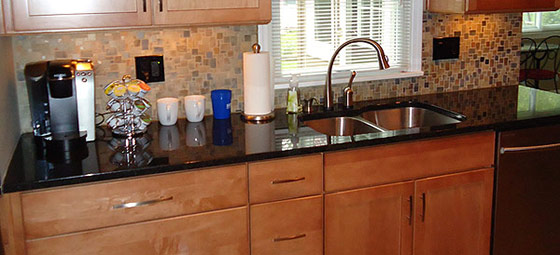The kitchen is often the most used room in the house. Whether your kitchen is small or spacious, proper organization will go a long way toward making it more efficient and functional.
Start out by clearing everything out of all of your cabinets, drawers, and pantry and place them onto the countertops and table. Take this opportunity to give everything a thorough cleaning. You might even consider lining shelves and drawer with attractive paper. Toss any food items that have expired, along with any broken kitchen equipment. Donate or give away any appliances or gadgets that you rarely use.
Once everything is out, start sorting. Think carefully about how you use your kitchen and create a logical organizational plan. Group items by purpose and locate all of the tools and utensils nearby. Some logical groupings include:
Food – Place all of your food items together and organize by type, such as all of the boxed foods in one spot, all the canned foods in another, and so on. Pantries and cabinets are perfect for this purpose.
Prep – Place everything you need to prepare food together in this area. This would include basic ingredients, mixing equipment, measuring cups and spoons, cutting boards, and knives. Ideally this would be close to the sink area.
Cook – The cooking zone would include pots, pans, and cooking utensils. Locate these items next to the stove.
Serve – Store all of your silverware, tableware, and serving dishes together. You can either place them close to the table or close to the dishwasher.
Clean – Keep things like dishwasher detergent, cleaning supplies, gloves, and extra trash bags under the sink. A drawer near the sink is an ideal spot for towels and dishrags.
Once you have everything sorted into groups and have a general idea of where you’ll store them, it’s time to start putting things away. This is the time to incorporate strategies for keeping your kitchen organized. Some ideas include:
- Keep as few items on the counters as possible. This makes it easier to keep your counters clean and provides maximum workspace.
- Put items you use on a regular basis within easy reach. Items you use infrequently can be stored on higher shelves. If your kitchen is small and lacking sufficient storage space, consider storing those infrequently used appliances and cookware elsewhere, such as the garage, basement, laundry room, or other storage space.
- Assign drawers for specific purposes. For example, dedicate one drawer for cutlery, one for baking tools, one for food packaging supplies (baggies, aluminum foil, plastic wrap, etc.), one for utensils, and one for towels and dishrags. Clear acrylic dividers will help to keep contents organized.
- If you have a pantry, add an over-the-door organizer to the back of the door to increase usable storage space. This is a great place for organizing small items, like snacks, seasoning packets, or it could even be converted into a spice rack.
- If you’re storing spices in a cabinet, adding a pull-out shelf will make it much easier to find those spices that end up tucked in the back. Attach metal spice containers to the back of the cabinet door with magnetic strips for easy access.
- Clear plastic bins and wire baskets are invaluable tools for keeping things organized. Use them in the pantry and cabinets to keep items grouped together and easy to access. Label them so you know where everything is. Because they’re see-through, you can quickly see when it’s time to restock certain items.
- Food in the freezer can quickly become a cluttered mess, making it hard to find what you need when you need it. Plastic containers are a great way to organize your freezer contents.
- Divide bagged and boxed snacks into individual portions and store in snack-size baggies or reusable plastic containers. Store them in a plastic bin so you can grab them on the go.
- Adding sliding shelf organizers or pull-out shelves to your cabinets make it easy to find and access what you need quickly.
- Every kitchen has a junk drawer. Clear acrylic dividers are a great way to tame the mess and make this drawer functional again.
- Make use of under-cabinet space by installing lighting, towel rods, or even a retractable book stand for holding cookbooks.
- Create a custom grocery list that you can keep attached to a clipboard in a handy place. Create categories and add space to meal plan for the week. When you notice you’re running low on an item, jot it down in the appropriate spot on the list.
- If you must handle mail and other paper in the kitchen, create a dedicated, proper space for it, complete with a plan for keeping it organized. If you want to free up some counter space, consider creating a wall-mounted mail center. Include a bulletin board, white board and hanging sorting bin.
Once you have your kitchen organized the way you want it, use labels to indicate where everything goes. This will help you stay organized and enable family and guests to find what they need and return it to where it belongs.

